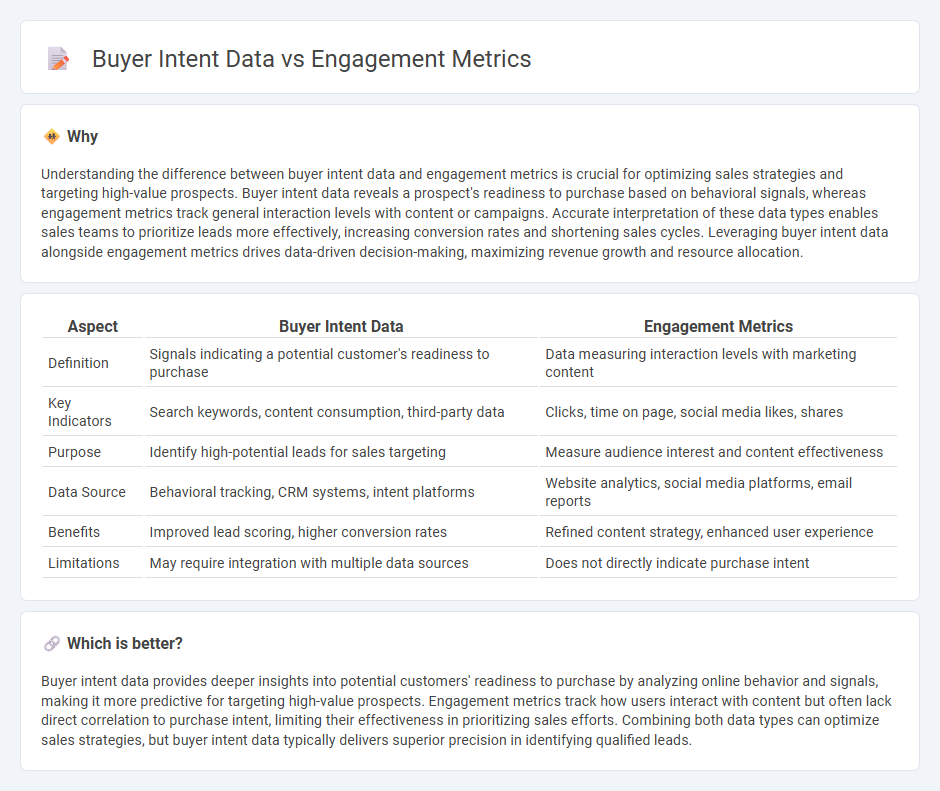
Buyer intent data identifies potential customers based on their online behavior and signals indicating readiness to purchase, while engagement metrics measure interactions such as clicks, views, and time spent on content. Understanding buyer intent enables sales teams to prioritize high-value leads with greater accuracy, whereas engagement metrics provide insights into how audiences respond to marketing efforts. Explore the key differences to enhance your sales strategy and boost conversion rates.
Why it is important
Understanding the difference between buyer intent data and engagement metrics is crucial for optimizing sales strategies and targeting high-value prospects. Buyer intent data reveals a prospect's readiness to purchase based on behavioral signals, whereas engagement metrics track general interaction levels with content or campaigns. Accurate interpretation of these data types enables sales teams to prioritize leads more effectively, increasing conversion rates and shortening sales cycles. Leveraging buyer intent data alongside engagement metrics drives data-driven decision-making, maximizing revenue growth and resource allocation.
Comparison Table
| Aspect | Buyer Intent Data | Engagement Metrics |
|---|---|---|
| Definition | Signals indicating a potential customer's readiness to purchase | Data measuring interaction levels with marketing content |
| Key Indicators | Search keywords, content consumption, third-party data | Clicks, time on page, social media likes, shares |
| Purpose | Identify high-potential leads for sales targeting | Measure audience interest and content effectiveness |
| Data Source | Behavioral tracking, CRM systems, intent platforms | Website analytics, social media platforms, email reports |
| Benefits | Improved lead scoring, higher conversion rates | Refined content strategy, enhanced user experience |
| Limitations | May require integration with multiple data sources | Does not directly indicate purchase intent |
Which is better?
Buyer intent data provides deeper insights into potential customers' readiness to purchase by analyzing online behavior and signals, making it more predictive for targeting high-value prospects. Engagement metrics track how users interact with content but often lack direct correlation to purchase intent, limiting their effectiveness in prioritizing sales efforts. Combining both data types can optimize sales strategies, but buyer intent data typically delivers superior precision in identifying qualified leads.
Connection
Buyer intent data reveals specific signals about a prospect's readiness to purchase by tracking digital behaviors such as content consumption and search queries, while engagement metrics measure interactions like clicks, time spent, and social shares. Analyzing these datasets together enhances sales teams' ability to prioritize leads, tailor outreach strategies, and predict conversion likelihood. Integrating buyer intent with engagement insights drives more effective targeting, increasing overall sales efficiency and revenue growth.
Key Terms
Engagement Metrics:
Engagement metrics measure how users interact with content through clicks, time spent, and page views, providing actionable insights into customer behavior and content effectiveness. These metrics enable marketers to optimize campaigns by identifying highly engaged audiences and tailoring messaging for improved conversion rates. Explore deeper to understand how engagement metrics can drive precision in targeting and boost overall marketing ROI.
Click-Through Rate (CTR)
Click-Through Rate (CTR) serves as a key engagement metric reflecting how often users click on a link compared to how many times it is viewed, providing insight into content relevance and effectiveness. Buyer intent data dives deeper by analyzing behaviors and signals indicating a prospect's readiness to purchase, offering a more predictive and actionable understanding of potential customers. Explore how combining CTR with buyer intent data can enhance targeted marketing strategies and improve conversion rates.
Time on Page
Time on Page serves as a critical engagement metric indicating how long a visitor spends on specific content, reflecting interest but not necessarily purchase readiness. Buyer intent data integrates Time on Page with other behavioral signals such as page visit frequency and content type interactions to more accurately predict a prospect's likelihood to convert. Explore how combining these insights can enhance targeted marketing strategies and boost conversion rates.
Source and External Links
Top 10 customer engagement metrics to measure in 2025 - Key engagement metrics include conversion rate, pages per session, Net Promoter Score, average session duration, customer satisfaction, retention rate, and churn rate, all essential for assessing campaign effectiveness.
What is User Engagement? How to Measure It? - User engagement is measured through metrics like click-through rate, time on page, returning visitor rate, pages per visit, session duration, and retention rate, which help evaluate user interaction and loyalty.
11 Important User Engagement Metrics for You To Track - Important user engagement metrics include page views, session duration, bounce rate, retention rate, and feedback response rates to analyze content reach and user involvement.
 dowidth.com
dowidth.com